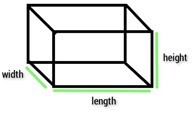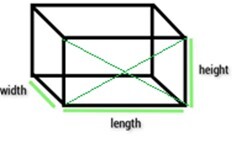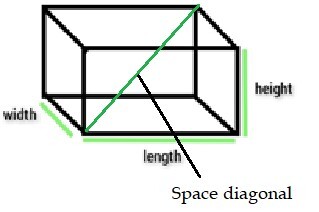
 Data Structure
Data Structure Networking
Networking RDBMS
RDBMS Operating System
Operating System Java
Java MS Excel
MS Excel iOS
iOS HTML
HTML CSS
CSS Android
Android Python
Python C Programming
C Programming C++
C++ C#
C# MongoDB
MongoDB MySQL
MySQL Javascript
Javascript PHP
PHP
- Selected Reading
- UPSC IAS Exams Notes
- Developer's Best Practices
- Questions and Answers
- Effective Resume Writing
- HR Interview Questions
- Computer Glossary
- Who is Who
Cuboid
Introduction
A cuboid is a solid shape or a three-dimensional shape in geometry. A cuboid is an 8 vertices, 12 edges, and 6 rectangular faces convex polyhedron. A cuboid is also known as a rectangular prism. An example of a cuboid in the real world is a rectangular box.
What is cuboid?
Imagine a shape that results from stacking numerous congruent rectangles on top of one another. The resultant shape is known as a cuboid.

Dimensions of a Cuboid
In order to describe the length, width (breadth), or height of an edge of a cuboid shape, it should be emphasised that there is no universal formula. The cuboid's horizontal face is assumed to have two dimensions: length and width, with length being the larger of the two. The height of a cuboid is thought to correspond to the length of any vertical edge when it is set flat on a table. The letters "l," "w," and "h" stand for the cuboid's length, width (breadth), and height, respectively. A cuboid's edge is the portion of a line joining two adjacent vertices, its vertex is the location where two or more edges meet, and its face is its flat surface.
Cuboid Faces Edges Vertices
There is a set number of faces, edges, and vertices on every 3D shape. A cuboid has six faces, twelve edges, and eight vertices. A cuboid has 2 top and bottom faces in addition to its 4 lateral faces. They are all rectangle-shaped. It features 12 edges, including 4 connecting edges and 8 edges on the top and bottom sides. The top and bottom faces' vertices make up its additional 8 vertices. At each vertex, three segments from each of the three dimensions come together.
Cuboid Formulas
Consider the following table to show the fundamental cuboid formulas. A cuboid has three main dimensions: l, w, and h..
| Face Diagonals | $\mathrm{\sqrt{(l^{2}\:+\:w^{2})}\:units}$ |
| Space Diagonals | $\mathrm{\sqrt{(l^{2}\:+\:w^{2}\:+\:h^{2})}\:units}$ |
| Perimeter | $\mathrm{4(l\:+\:w\:+\:h)\:units}$ |
Diagonals of a Cuboid
A cuboid has two different kinds of diagonals because it is a three-dimensional shape
Diagonal faces
Spatially Diagonal
Look at the following illustration, which depicts a cuboid's face and space diagonals.
Face Diagonal
The opposite vertices of a certain cuboid face can be connected to form face diagonals, but only two diagonals can be formed on a single cuboid face. A cuboid can be drawn with a total of 12 face diagonals since it has 6 faces.

Space diagonal
A line segment connecting a cuboid's opposing vertices is known as a space diagonal. The interior of the cuboid is traversed by the space diagonals. So it is possible to draw 4 space diagonals inside of it.

Surface Area of Cuboid
A cuboid's surface area is the whole area that the shape takes up. The surface area of a cuboid will depend on its length, breadth, and height because it is a three-dimensional object. Total surface area and lateral surface area are two different types of surface areas that it may have. As a result, the following formulas are provided to determine a cuboid's surface area:
Cuboid's overall surface area is equal to $\mathrm{S\:=\:2\:(lb\:+\:bh\:+\:lh)\:square\:units.}$
$$\mathrm{l\:=\:2h(l\:+\:b)\:square\:units\:is\:cuboid\:Lateral\:Surface\:Area}$$
where,
l = Length,
b = Breadth,
h = Height,
S = Total surface area, and
L = Lateral surface area
Volume of Cuboid
The volume of a cuboid is used to determine how much space it occupies. A cuboid's length, breadth, and height determine its volume. As a result, altering any one of these values alters the shape's volume. The cubic unit is used to express the volume of a cuboid. So, the following is the formula to get the cuboid's volume
Hence, the $\mathrm{volume\:of\:a\:cuboid\:,\:V\:=\:l\times\:b\times\:h\:=\:lbh\:cubic\:units.}$
where,
l = Length
b = Breadth, and
h = Height
Cuboid Properties
The key characteristics of a cuboid make it simple to recognise one. These are what they are
A cuboid has 6 faces, 8 vertices, and 12 edges
Only straight angles are created at the vertices of a cuboid
The shapes of all the faces are rectangles.
Two diagonal lines can be drawn on each face of a cuboid.
The edges on either side of each other are parallel.
A cuboid has the following measurements: length, breadth, and height.
A Few Examples of Cuboids from Real Life
We've compiled a list of some real-world cuboids. Look over the list to see if you can find any of these when you're out and try to see if you have got your own to add
Buildings Take a look at the buildings as you stroll around a town or metropolis. You'll note that many of them have cuboidal shapes.
Boxes Pay attention to the boxes when you browse the supermarket, pick out a new pair of shoes, or unwrap a gift. The majority of the boxes are cuboid in shape, as you'll see.
Conclusion
In this tutorial, we learned about cuboids the properties of a cuboid. A cuboid is a rectangular prism. The Volume of a cuboid is given by $\mathrm{l\times\:b\times\:h}$, and the Lateral surface area is given by $\mathrm{2(l\:+\:b)\times\:h}$ and Total surface area is given by, $\mathrm{2(lb\:+\:bh\:+\:hl)}$.
FAQs
1. What is the diagonal measurement of a cuboid with dimensions of 7 by 6 by 3 units?
A cuboid formula has a diagonal length of $\mathrm{\sqrt{(l^{2}\:+\:w^{2}\:+\:h^{2})}}$ units.
Assume that length (l) = 7, width (w), = 6, and height (h), = 3
As a result, the diagonal's length is equal to $\mathrm{\sqrt{(7^{2}\:+\:6^{2}\:+\:3^{2})}}$ units.
Therefore, $\mathrm{The\:length\:of\:diagonal\:=\:\sqrt{(7^{2}\:+\:6^{2}\:+\:3^{2})}}$
$\mathrm{\:\:\:\:\:\:\:\:\:\:\:\:\:\:\:\:\:\:\:\:\:\:\:\:\:\:\:\:\:\:\:\:\:\:\:\:\:\:\:\:\:\:\:\:\:\:\:\:\:\:\:\:\:\:\:\:\:\:\:\:\:\:\:\:=\:\sqrt{(49\:+\:36\:+\:9)}\:units\:=\:\sqrt{94}\:units}$
2. David owns a cuboidal box with measurements of 12 by 7 by 5. What is the box's volume?
Cuboid volume = length, width, and height in cubic units. By changing the variables provided, we obtain
$\mathrm{Volume\:=\:12\times\:7\times\:5\:cubic\:inches}$
$\mathrm{Volume\:=\:420\:cubic\:inches}$
3. Determine the cuboid's surface area. Its dimensions are 8 by 6 by 4 units?
The formula for a cuboid's surface area is 2(lw + wh + lh) square units. Let's calculate the length (l) at 8 units, the width (w) at 6 units, and the height (h) at 4 units using the provided dimensions.
Therefore, the surface area $\mathrm{=\:2\:\lbrace\:(8\times\:6)\:+\:(6\times\:4)\:+\:(8\times\:4)\rbrace}$
$\mathrm{\:\:\:\:\:\:\:\:\:\:\:\:\:\:\:\:\:\:\:\:\:\:\:\:\:\:\:\:\:\:\:\:\:\:\:\:\:\:\:\:\:\:\:\:\:\:\:\:\:=\:2(48\:+\:24\:+\:32)\:square\:units\:=\:2(104)\:=\:208\:square\:units.}$
4. What distinguishes a cuboid from a rectangular prism?
Since both will have 6 rectangular faces, 8 vertices, and 12 edges, the cuboid and rectangular prism are identical. Furthermore, both have a box-like appearance.

